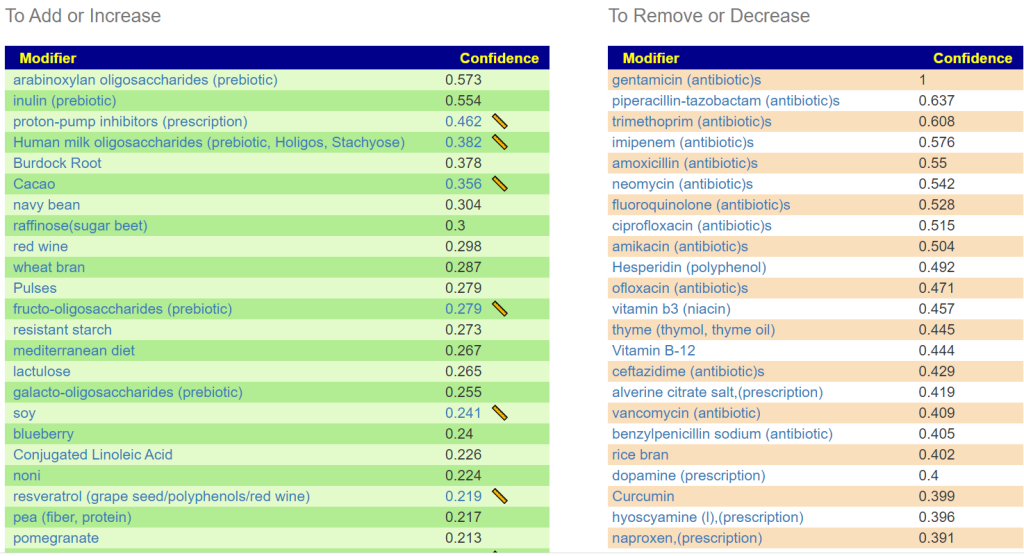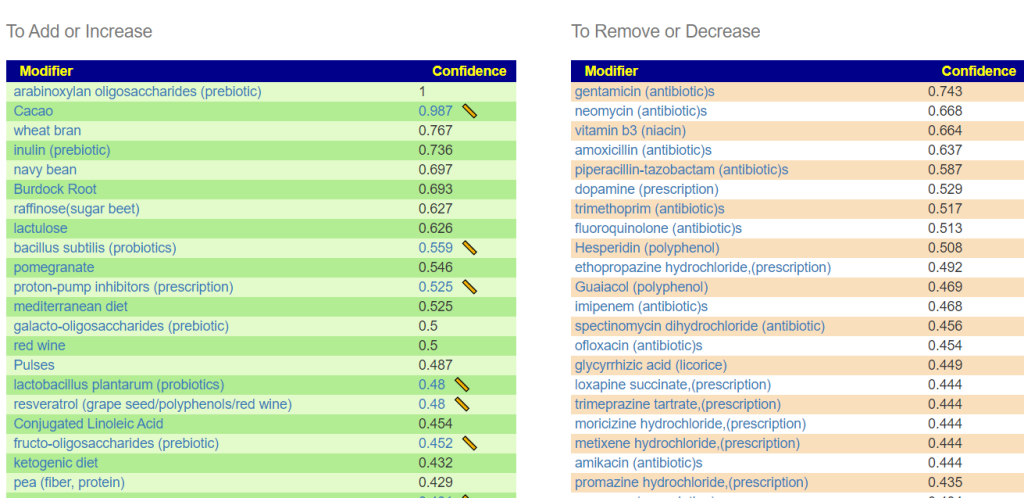This is a common symptom for many people. This is reported often in samples, and thus being examined if it reaches our threshold for inclusion as defined in A new specialized selection of suggestions links. It does.
- “Motility” is a term used to describe the contraction of the muscles that mix and propel contents in the gastrointestinal (GI) tract. [Src] thus it has similarity to constipation (See Special Studies: Constipation)
- “An excess of intracolonic saturated long-chain fatty acids (SLCFAs) was associated with enhanced bowel motility in NMS rats. Heptadecanoic acid (C17:0) and stearic acid (C18:0), as the most abundant odd- and even-numbered carbon SLCFAs in the colon lumen, can promote rat colonic muscle contraction and increase stool frequency” [2018]
Study Populations:
| Symptom | Reference | Study |
| Poor gut motility | 1171 | 55 |
- Bacteria Detected with z-score > 2.6: found 170 items, highest z-score value was 8.8
- Enzymes Detected with z-score > 2.6: found 336 items, highest z-score value was 6.4
- Compound Detected with z-score > 2.6: found No items

Interesting Significant Bacteria
All bacteria that was found significant are too low. This is a common pattern for most of the special studies and really challenge the internet myth of the cause being too many bad bacteria. One bacteria really stands out — and there is ongoing work on making this one bacteria, Prevotella copri , available as a probiotics!
| Bacteria | Reference Mean | Study | Z-Score |
| Prevotella copri (species) | 64568 | 5498 | 8.8 |
| Sutterella stercoricanis (species) | 3098 | 410 | 7.5 |
| Prevotella paludivivens (species) | 144 | 26 | 7.1 |
| Prevotella (genus) | 72220 | 20587 | 6.2 |
| Alkalibacterium (genus) | 102 | 21 | 6 |
| Prevotellaceae (family) | 79801 | 32549 | 5.2 |
| Leptospiraceae (family) | 67 | 24 | 5.2 |
| Leptospira (genus) | 67 | 24 | 5.2 |
| Leptospirales (order) | 67 | 24 | 5.2 |
| Leptospira licerasiae (species) | 67 | 24 | 5.2 |
| Ruminiclostridium (genus) | 1000 | 348 | 5.1 |
| Phocaeicola sartorii (species) | 807 | 375 | 5.1 |
- “For example, abundances of Lactobacillus, Prevotella and Alistipes spp. are significantly decreased in patients with constipation ” [2018]
Interesting Enzymes
Most of the enzymes are too low, however a few are too high which is not the usual pattern seen in other of these special studies.
| S-methyl-5′-thioadenosine:phosphate S-methyl-5-thio-alpha-D-ribosyl-transferase (2.4.2.28) | 3740 | 1373 | 6.4 |
| n/a (3.4.14.13) | 1270 | 248 | 5.9 |
| D-alanine:2-oxoglutarate aminotransferase (2.6.1.21) | 2687 | 959 | 5.9 |
| 1-aminocyclopropane-1-carboxylate aminohydrolase (isomerizing) (3.5.99.7) | 1428 | 337 | 5.9 |
| succinyl-CoA:3-oxo-acid CoA-transferase (2.8.3.5) | 1307 | 291 | 5.8 |
| N-acyl-D-amino acid amidohydrolase (3.5.1.81) | 1777 | 396 | 5.8 |
| 4-hydroxyphenylpyruvate:oxygen oxidoreductase (hydroxylating, decarboxylating) (1.13.11.27) | 1446 | 225 | 5.6 |
| carotenoid beta-end group lyase (ring-opening) (5.5.1.19) | 1450 | 134 | 5.6 |
| ATP:L-threonine O3-phosphotransferase (2.7.1.177) | 2320 | 486 | 5.6 |
| n/a (3.4.15.6) | 1585 | 391 | 5.6 |
| hydrogen-sulfide:flavocytochrome c oxidoreductase (1.8.2.3) | 1164 | 108 | 5.5 |
| 15-cis-phytoene:acceptor oxidoreductase (lycopene-forming) (1.3.99.31) | 2233 | 902 | 5.5 |
| all-trans-zeta-carotene:acceptor oxidoreductase (1.3.99.26) | 2233 | 902 | 5.5 |
| 15-cis-phytoene:acceptor oxidoreductase (zeta-carotene-forming) (1.3.99.29) | 2233 | 902 | 5.5 |
| 15-cis-phytoene:acceptor oxidoreductase (neurosporene-forming) (1.3.99.28) | 2233 | 902 | 5.5 |
| [SoxY protein]-S-sulfosulfanyl-L-cysteine sulfohydrolase (3.1.6.20) | 1183 | 106 | 5.5 |
| CTP:5,7-diacetamido-3,5,7,9-tetradeoxy-L-glycero-alpha-L-manno-nonulosonic acid cytidylyltransferase (2.7.7.81) | 1139 | 119 | 5.5 |
| medium-chain acyl-CoA:electron-transfer flavoprotein 2,3-oxidoreductase (1.3.8.7) | 1300 | 325 | 5.4 |
| 2-carboxy-2,5-dihydro-5-oxofuran-2-acetate lyase (ring-opening) (5.5.1.2) | 1332 | 198 | 5.3 |
| sulfite:oxygen oxidoreductase (1.8.3.1) | 1199 | 107 | 5.3 |
| alkane,reduced-rubredoxin:oxygen 1-oxidoreductase (1.14.15.3) | 1087 | 107 | 5.3 |
| 4-hydroxybenzoate,NADPH:oxygen oxidoreductase (3-hydroxylating) (1.14.13.2) | 1319 | 203 | 5.2 |
| protocatechuate:oxygen 3,4-oxidoreductase (ring-opening) (1.13.11.3) | 1319 | 199 | 5.2 |
| dihydro-NAD(P):oxygen oxidoreductase (H2O2-forming) (1.6.3.5) | 1290 | 145 | 5.2 |
| glutaryl-CoA:electron-transfer flavoprotein 2,3-oxidoreductase (decarboxylating) (1.3.8.6) | 1257 | 258 | 5.2 |
| 3-methylcrotonoyl-CoA:carbon-dioxide ligase (ADP-forming) (6.4.1.4) | 1114 | 205 | 5.1 |
| N-acyl-L-homoserine-lactone amidohydrolase (3.5.1.97) | 1044 | 126 | 5.1 |
| 4a-hydroxytetrahydrobiopterin hydro-lyase (6,7-dihydrobiopterin-forming) (4.2.1.96) | 1314 | 223 | 5.1 |
Too High Enzymes
| Enzyme | Reference Mean | Study Mean | Z-Score |
| L-leucyl-tRNALeu:[protein] N-terminal L-lysine/L-arginine leucyltransferase (2.3.2.6) | 130285 | 170931 | -2.9 |
| polyphosphate phosphohydrolase (3.6.1.11) | 171217 | 211918 | -2.8 |
| guanosine-5′-triphosphate-3′-diphosphate 5′-phosphohydrolase (3.6.1.40) | 171217 | 211918 | -2.8 |
| 1-deoxy-D-xylulose 5-phosphate:thiol sulfurtransferase (2.8.1.10) | 198195 | 242062 | -2.7 |
| (R)-2-carboxy-2,5-dihydro-5-oxofuran-2-acetate carboxy-lyase (4,5-dihydro-5-oxofuran-2-acetate-forming) (4.1.1.44) | 199133 | 242528 | -2.7 |
| ATP phosphohydrolase (P-type, Ca2+-transporting) (7.2.2.10) | 234154 | 280063 | -2.7 |
| acetyl-CoA:maltose O-acetyltransferase (2.3.1.79) | 206724 | 252634 | -2.7 |
| 3-methylbut-3-en-1-yl-diphosphate:ferredoxin oxidoreductase (1.17.7.4) | 239452 | 285669 | -2.7 |
| L-aspartate:tRNAAsp ligase (AMP-forming) (6.1.1.12) | 244534 | 289637 | -2.6 |
| 5,10-methylenetetrahydrofolate:dUMP C-methyltransferase (2.1.1.45) | 245078 | 290417 | -2.6 |
| D-arabinose aldose-ketose-isomerase (5.3.1.3) | 188214 | 231505 | -2.6 |
| L-fucose aldose-ketose-isomerase (5.3.1.25) | 188214 | 231505 | -2.6 |
| 5,6,7,8-tetrahydrofolate:NADP+ oxidoreductase (1.5.1.3) | 247230 | 291626 | -2.6 |
Bottom Line
While poor gut motility is often assumed to be due too many of some bacteria, the evidence suggestions that not enough is the more likely cause. There appears to be no simple model or answer.
- “The gut bacterium Prevotella copri (P. copri) has been shown to lower blood glucose levels in mice as well as in healthy humans, and is a promising candidate for a next generation probiotic aiming at prevention or treatment of obesity and type 2 diabetes” [2021]
- Cultivation of the gut bacterium Prevotella copri DSM 18205T using glucose and xylose as carbon sources
- Prevotella copri as Next Generation Probiotics [firm that provides different strains for research purposes]
Prevotella copri will hopefully be available as a probiotic in a few year. There are two natural sources for P.Copri : Beer and Sauerkraut [2020], which may be an experiment for those that are prone to poor gut motility..
- “This species is more prevalent in non-Western populations likely due to its association with high fibre low fat diets” [2022]
- “Across all ethnicities, only coffee consumption was associated with an increased Prevotella relative abundance ” [2022]
- “Ancient stool samples suggest Westernization leads to P. copri underrepresentation” [2019]

The real bottom line is changing diet significantly. Consider some Indian style of food as part of supper every day, some examples ready to heat are here.

It should be noted that the B-Vitamins below are likely in the avoid list because they are usually provided thru meat in traditional diet.




















Recent Comments